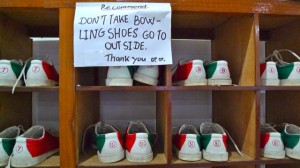 Laos has this informal curfew that is more of an irritant than a strict law.
Laos has this informal curfew that is more of an irritant than a strict law.
I never saw police enforcing the rule. However, all the bars close up shop early. Bartenders tip your bottled beer into a plastic cup and shove you out the door around 11 p.m. Generally everybody is off the streets by midnight.
That’s when the taxi drivers creep up to you on the street corners and whisper, “Bowling alley?”
My friends and I thought it was secret code for “opium den.” And so we jumped into a taxi, of course, headed straight into the unknown.
About 20 minutes later, the taxi screeched to a halt in front of a dark building.
A bowling alley.
This, it turns out, was the epicenter of Laotian nightlife.
There were two drink selections on the menu. Beer was 20,000 kip for a large bottle — nearly double the price of what you’d pay at a bar during normal hours. But a full liter of Lao whiskey was just 30,000 kip, which is less than $4. Our choice was a no-brainer.
Then my friends Sam, Rose, Nick and I started throwing around gutter balls.
The funny thing about bowling in Laos is that nobody wears the questionably stylish shoes — which is, in my opinion, half the fun of bowling. We simply shucked our flip flops and skidded around in our bare feet.
We stayed out until 2 a.m., though the bowling alley keeps rocking until 4 a.m.
I don’t even remember who won. (Perhaps my mind was curdled from all the whiskey?) But bowling in Lunag Prabang ranks at the top of my list for wacky fun in Southeast Asia — breaking the law, Dude-style.





























